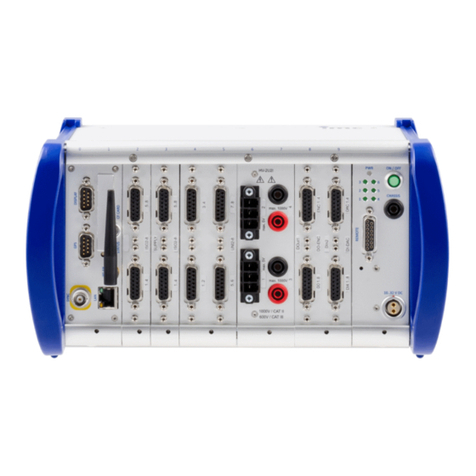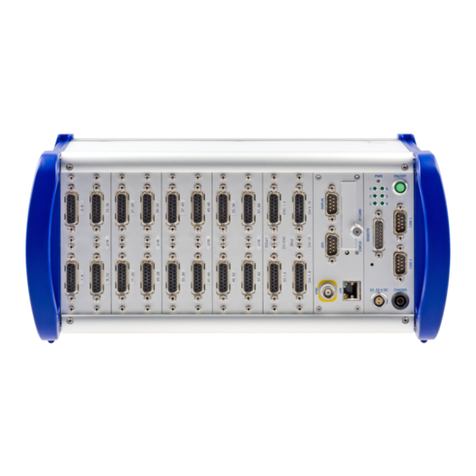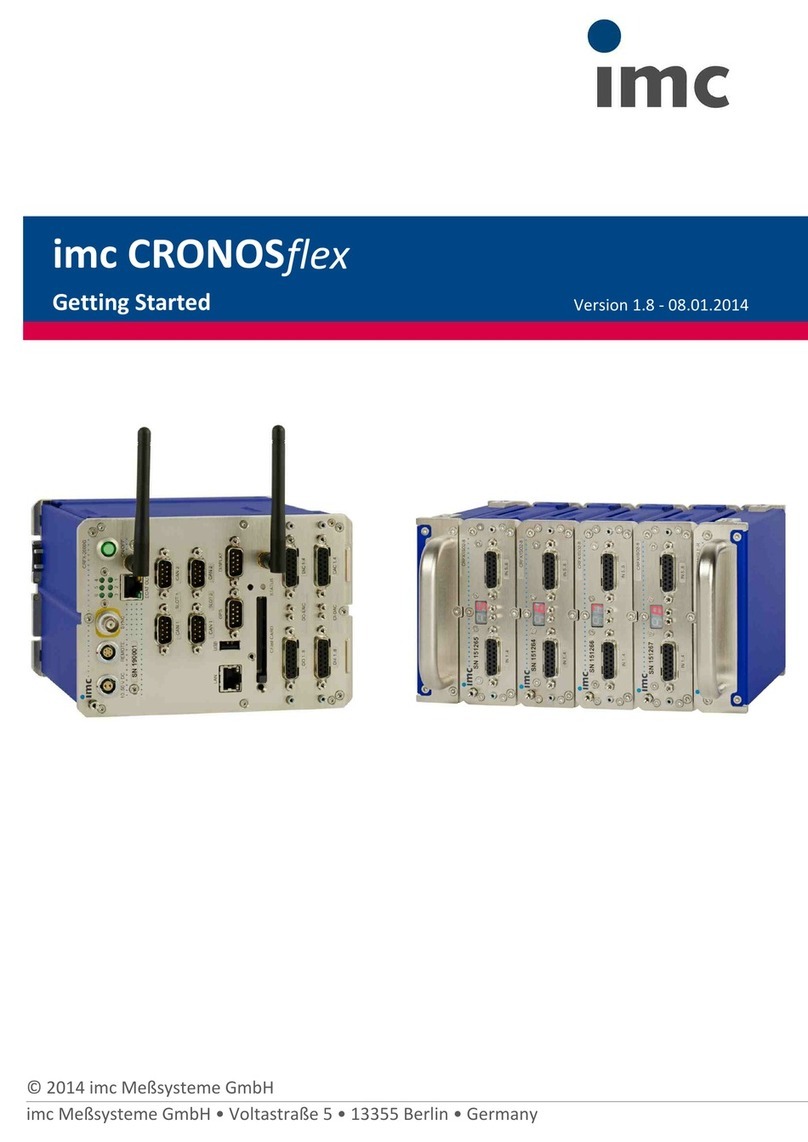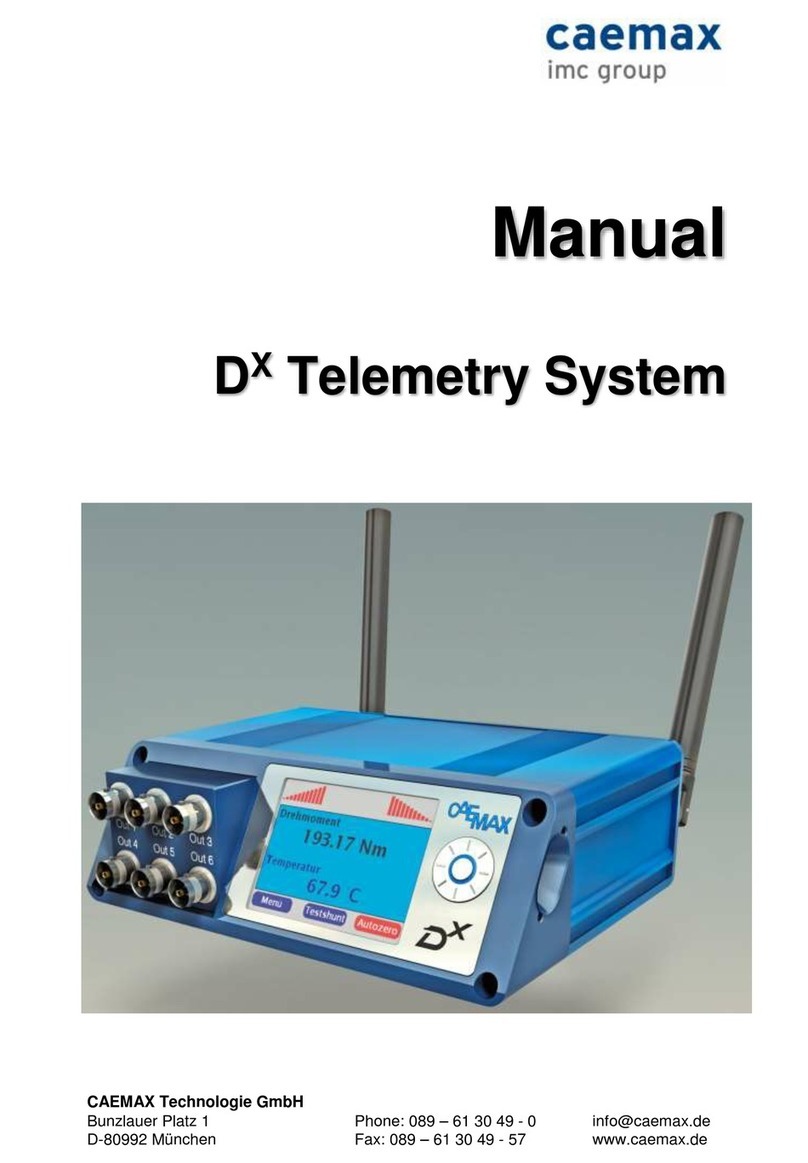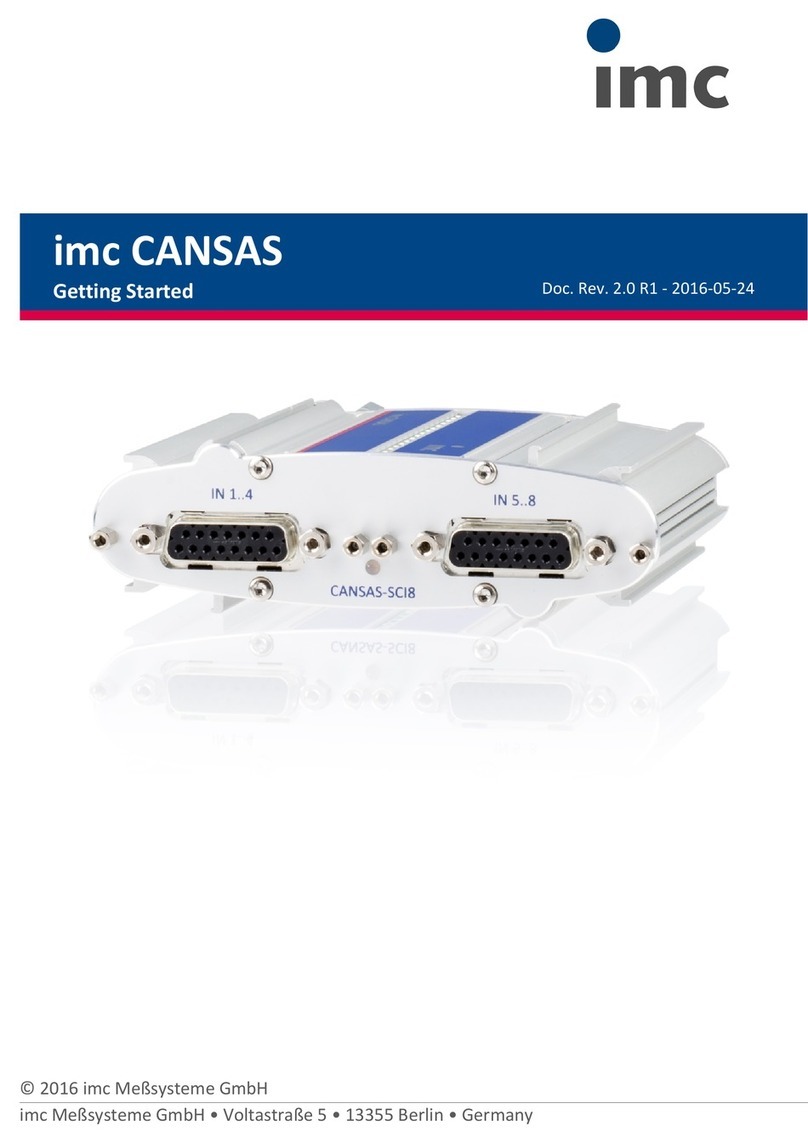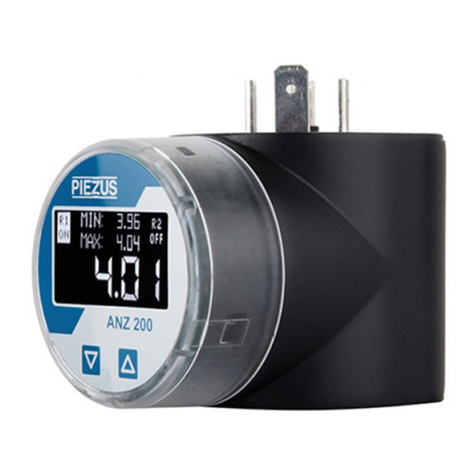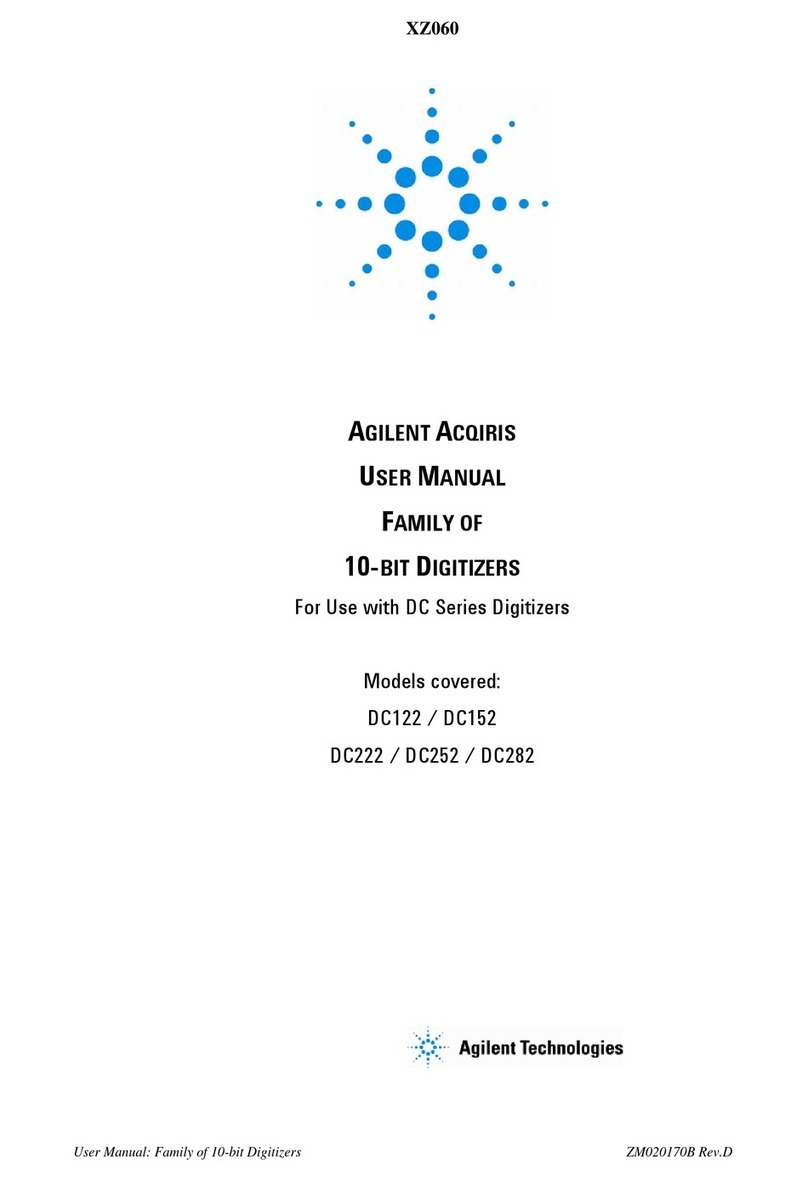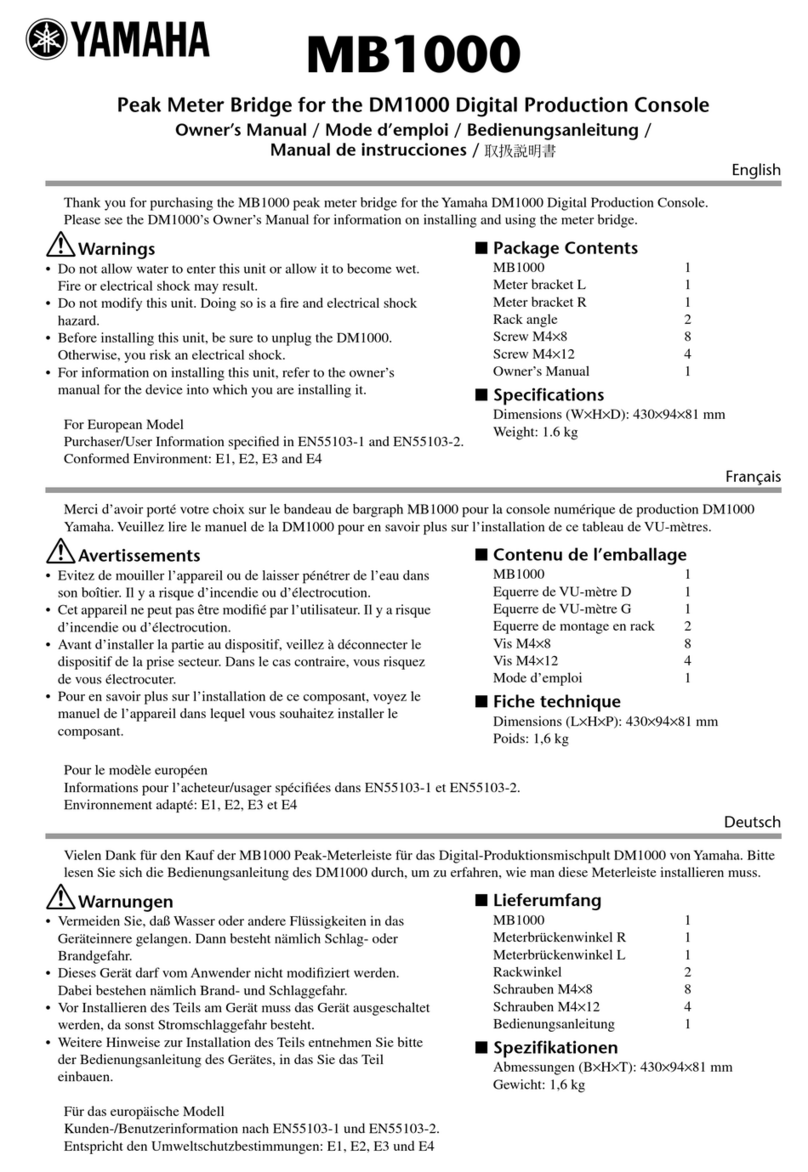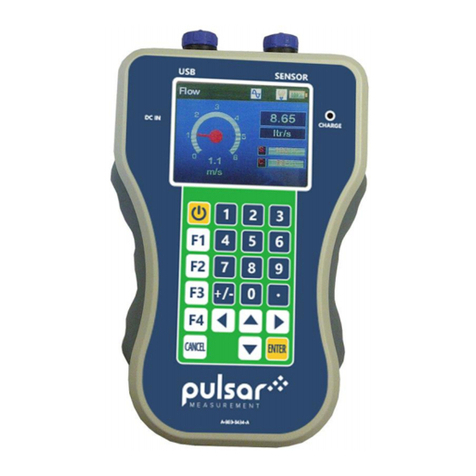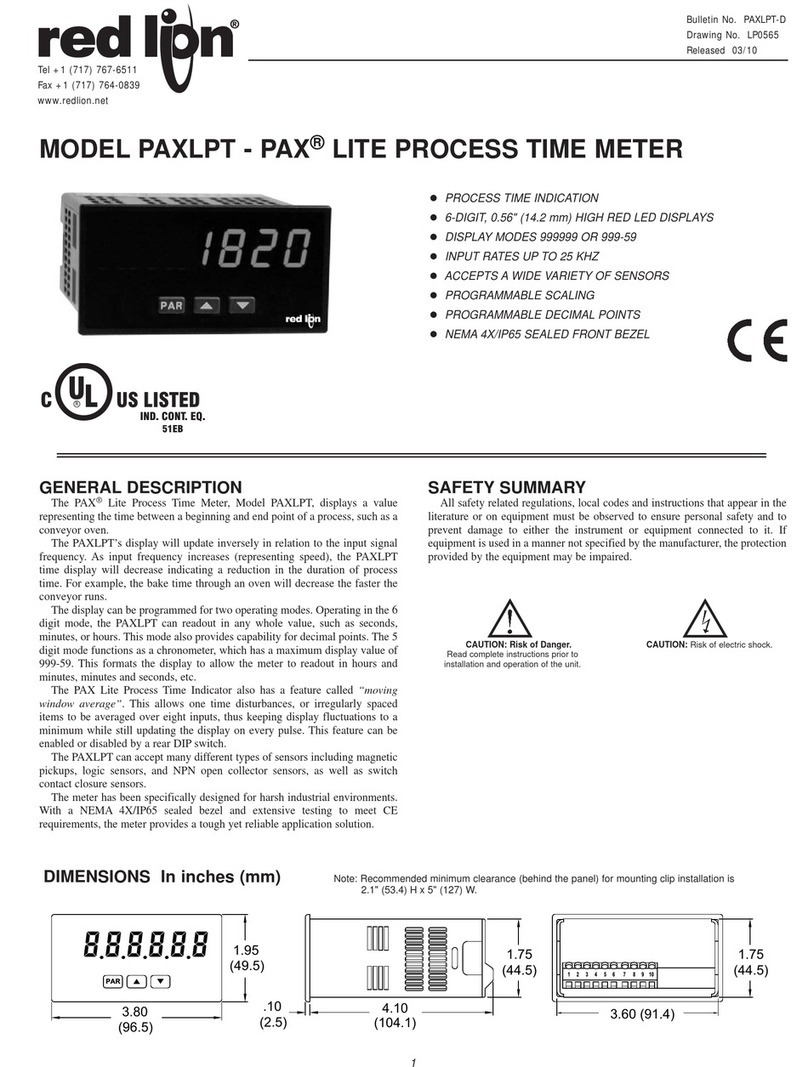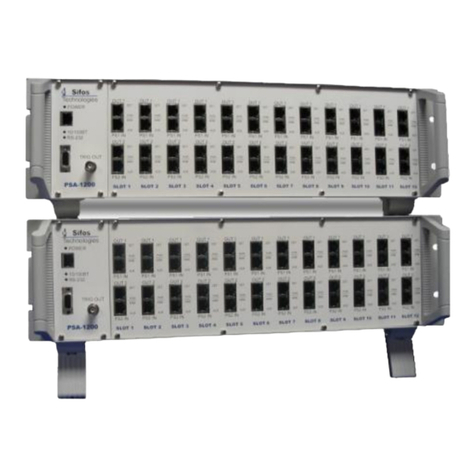IMC C SERIES User manual

imc Test & Measurement GmbH • Voltastraße 5 • 13355 Berlin • Germany
© 2018 imc Test & Measurement GmbH
imc C-SERIES
Manual
Version 4 R 3 - 2018-10-19

© 2018 imc Test & Measurement GmbH imc C-SERIES - Manual, Version 4 R 3 - 2018-10-19
Foreword
Thank you for deciding to purchase our product. We wish you total success in accomplishing your
measurement assignments with the help of your hardware and software. If you have any open questions
Disclaimer of liability
The contents of this documentation have been carefully checked for consistency with the hardware and
software systems described. Nevertheless, it is impossible to completely rule out inconsistencies, so that
we decline to offer any guarantee of total conformity.
We gratefully accept any suggestions for improvements, please contact our Hotline ([email protected]).
We reserve the right to make technical modifications of the systems.
Copyright
© 2018 imc Test & Measurement GmbH, Germany
This documentation is the intellectual property of imc Test & Measurement GmbH. imc Test &
Measurement GmbH reserves all rights to this documentation. The applicable provisions are stipulated in
the "imc Software License Agreement".
The software described in this document may only be used in accordance with the provisions of the "imc
Software License Agreement".
imc Software and Microsoft® Windows
imc software runs on the Microsoft® Windows operating system.
GPL Sources
Some components of our hardware use software, that is licensed under GNU General Public License
(GPL). If you would like a copy of the GPL source code contained in this product please contact our
Hotline.

© 2018 imc Test & Measurement GmbH imc C-SERIES - Manual, Version 4 R 3 - 2018-10-19
Table of Contents 3
1 General ............................................................................................................ 5
1.1 Notes / Quality Management ............................................................................................. 5
1.2 imc Customer Support / Hotline ......................................................................................... 7
1.3 Instruction manual .............................................................................................................. 8
1.4 Liability limitations .............................................................................................................. 8
1.5 Guarantee ........................................................................................................................... 8
1.6 Before starting .................................................................................................................... 8
1.7 Notes on maintenance and servicing ................................................................................. 9
1.8 Safety .................................................................................................................................. 9
1.9 After unpacking... .............................................................................................................. 11
1.10 Transport ......................................................................................................................... 11
1.11 Storage ............................................................................................................................ 11
1.12 Cleaning ........................................................................................................................... 11
2 Start of operation with the Hardware ............................................................ 12
2.1 Precautions for operation ................................................................................................. 12
2.2 Power supply ..................................................................................................................... 13
2.3 Grounding, shielding ......................................................................................................... 14
2.4 Devices with non-isolated power supply .......................................................................... 14
2.5 Devices with isolated power supply ................................................................................. 14
2.6 Grounding with the use of the included power adapter ................................................. 14
2.7 Grounding with power supplied by a car battery ............................................................ 15
2.8 Shielding ............................................................................................................................ 15
2.9 Main switch ....................................................................................................................... 16
2.10 Potential difference with synchronized devices ............................................................ 17
2.11 Fuses (polarity-inversion protection) ............................................................................. 17
2.12 UPS .................................................................................................................................. 17
3 Start of operation Software / Firmware .......................................................... 19
3.1 Installation - Software ....................................................................................................... 19
3.2 Connecting via LAN in four steps ...................................................................................... 19
3.3 Firmware Update .............................................................................................................. 23
4 Properties of the imc C-SERIES ........................................................................ 27
4.1 Device Overview ............................................................................................................... 27
4.2 Operating software ........................................................................................................... 28
4.3 Sampling interval .............................................................................................................. 28
4.4 TEDS .................................................................................................................................. 28
4.5 Specific parameters .......................................................................................................... 29
4.6 Measurement types .......................................................................................................... 29
4.7 Measurement with current-fed sensors (IEPE) ................................................................ 51
4.8 Measure with IEPE/ICP expansion plug ............................................................................ 52
5 Device description .......................................................................................... 61
5.1 Hardware configuration of all devices .............................................................................. 61
5.2 Miscellaneous ................................................................................................................... 75

© 2018 imc Test & Measurement GmbH imc C-SERIES - Manual, Version 4 R 3 - 2018-10-19
Table of Contents4
5.3 CS-1016-FD ........................................................................................................................ 87
5.4 CS-1208-FD ........................................................................................................................ 89
5.5 CS-3008-FD ........................................................................................................................ 92
5.6 CS-4108-FD, CL-4124-FD ................................................................................................... 96
5.7 CS-5008-FD, CL-5016-FD ................................................................................................. 100
5.8 CS-7008-FD, CL-7016-FD ................................................................................................. 109
6 Technical Specs ............................................................................................. 125
6.1 General technical Specs .................................................................................................. 125
6.2 CS-1016-FD analog inputs ............................................................................................... 132
6.3 CS-1208-FD analog inputs ............................................................................................... 134
6.4 CS-3008-FD ...................................................................................................................... 137
6.5 CS-4108-FD, CL-4124-FD analog inputs .......................................................................... 139
6.6 CS-5008-FD, CL-5016-FD analog inputs .......................................................................... 143
6.7 CS-7008-FD, CL-7016-FD analog inputs .......................................................................... 147
6.8 Technical Specs: Features (for all devices of imc C-SERIES) ........................................... 152
6.9 CAN FD Interface ............................................................................................................. 156
6.10 Miscellaneous ............................................................................................................... 157
7 Pin configuration .......................................................................................... 167
7.1 Connecting DSUB-15 adapter plug ................................................................................. 168
7.2 Metal connector - handling ............................................................................................ 169
7.3 DSUB-15 pin configuration ............................................................................................. 170
7.4 Pin configuration of the REMOTE plug (female) ............................................................ 174
7.5 DSUB-9 pin configuration ............................................................................................... 174
8 Last Changes ................................................................................................. 177
9 Symbols and legend ...................................................................................... 178
Index ............................................................................................................... 179

© 2018 imc Test & Measurement GmbH imc C-SERIES - Manual, Version 4 R 3 - 2018-10-19
5Notes / Quality Management
1 General
1.1 Notes / Quality Management
Quality Management
imc Test & Measurement GmbH holds DIN-EN-ISO-9001
certification since May 1995. You can download the CE
Certification, current certificates and information about the
imc quality system on our Webpage: www.imc-tm.com/about-
imc/quality-assurance.
imc Warranty
Subject to the general terms and conditions of imc Test & Measurement GmbH.
ElektroG, RoHS 2, WEEE, CE
Reference
The manufacturer's declaration on ElektroG, RoHS, WEEE and the CE certification can be found on
the imc website: www.imc-tm.com
Product Improvement and change requests
Please help us to improve our documentation:
·
What terms or descriptions are incomprehensible?
·
What additions and enhancements you suggest?
·
Where have material mistakes slipped in?
·
Which spelling or typing errors have you found?
Responses and other feedback should be directed to the Hotline (phone / e-mail)
or by writing to: imc Test & Measurement GmbH, Voltastrasse 5 in 13355 Berlin, Germany
Remarks Concerning EMC
imc C-SERIES satisfies the EMC requirements for unrestricted use in industrial settings.
Any additional devices connected to imc C-SERIES must satisfy the EMC requirements as specified by
the responsible authority (within Europe1) in Germany the BNetzA - "Bundesnetzagentur" (formerly
BMPT-Vfg. No. 1046/84 or No. 243/91) or EC Guidelines 2014/30/EU. All products which satisfy these
requirements must be appropriately marked by the manufacturer or display the CE certification
marking.
Products not satisfying these requirements may only be used with special approval of the regulating
body in the country where operated.
All signal lines connected to imc C-SERIES must be shielded and the shielding must be grounded.
7

© 2018 imc Test & Measurement GmbH imc C-SERIES - Manual, Version 4 R 3 - 2018-10-19
6General
Note
The EMC tests were carried out using shielded and grounded input and output cables with the
exception of the power cord. Observe this condition when designing your experiment to ensure high
interference immunity and low jamming.
1If you are located outside Europe, please refer the appropriate EMC standards used in the country of operation.
FCC-Note
This equipment has been tested and found to comply with the limits for a Class B digital device,
pursuant to Part 15 of the FCC Rules (CFR 15.105)2. These limits are designed to provide reasonable
protection against harmful interference in a residential installation. This equipment generates, uses,
and can radiate radio frequency energy and, if not installed and used in accordance with the
instructions, may cause harmful interference to radio communications. However, there is no
guarantee that interference will not occur in a particular installation. If this equipment does cause
harmful interference to radio or television reception, which can be determined by turning the
equipment on and off, the user is encouraged to try to correct the interference by one or more of the
following measures:
·
Reorient or relocate the receiving antenna.
·
Increase the separation between the equipment and the receiver.
·
Connect the equipment into an outlet on a circuit different from that to which the receiver is
connected.
·
Consult our imc hotline or an experienced radio or television technician for help.
Modifications
The FCC requires the user to be notified that any changes or modifications made to this device that
are not expressly approved by imc may void the user's authority to operate this equipment.
2FCC - United States Federal Communications Commission
Cables
Connections to this device must be made with shielded cables with metallic RFI/EMI connector hoods
to maintain compliance with FCC Rules and Regulations.
Industrial Safety
We certify that imc C-SERIES in all product configuration options corresponding to this documentation
conforms to the directives in the accident prevention regulations in "Electric Installations and
Industrial Equipment" (DGUV Regulation 3)3.
This certification has the sole purpose of releasing imc from the obligation to have the electrical
equipment tested prior to first use (§ 5 Sec. 1, 4 of DGUV Regulation 3). This does not affect
guarantee and liability regulations of the civil code.
3Formerly BGV-A3
7

© 2018 imc Test & Measurement GmbH imc C-SERIES - Manual, Version 4 R 3 - 2018-10-19
7Notes / Quality Management
Observe Notes and Warnings
The measurement system has been carefully designed, assembled and routinely tested in accordance
with the safety regulations specified in the included certificate of conformity and has left imc in
perfect operating condition. To maintain this condition and to ensure continued danger-free
operation, the user should pay particular attention to the remarks and warnings made in this chapter.
In this way, you protect yourself and prevent the device from being damaged.
Read this manual before turning the device on for the first time.
Warning
Before touching the device sockets and the lines connected to them, make sure static electricity is
drained. Damage arising from electrostatic discharge is not covered by the warrantee.
Ambient temperature
The limits of the ambient temperature cannot be given as a lump sum because they depend on many
factors of the specific application and environment, such as air flow/convection, heat radiation
balance in the environment, mounting structure, system configuration/single or block (click),
connected cables, operating mode, etc. This is taken into account by specifying the operating
temperature instead. Furthermore, it is not possible to predict any sharp limits for electronic
components. Basically, reliability decreases when operating under extreme conditions (forced ageing).
The operating temperature data represent the extreme limits at which the function of all components
can still be guaranteed.
1.2 imc Customer Support / Hotline
If you have problems or questions, please contact our Customer Support/Hotline:
imc Test & Measurement GmbH
Hotline Berlin
(Germany):
+49 (0)30 / 467090-26
Hotline Frankfurt
(Germany):
+49 (0)6172 / 59672-40
E-Mail:
Internet:
www.imc-tm.com
International partners
For our international partners see www.imc-tm.com/our-partners/distributor.
Tip for ensuring quick processing of your questions:
If you contact us you would help us, if you know the serial number of your devices and the version info
of the software. This documentation should also be on hand. Thank you!
·
The device's serial number appears on the nameplate.
·
The program version designation is available in the About-Dialog.

© 2018 imc Test & Measurement GmbH imc C-SERIES - Manual, Version 4 R 3 - 2018-10-19
8General
1.3 Instruction manual
This instruction manual provides important notes on using the device. The safe working is conditional on
compliance with all safety measures and instruction specified.
Additionally, all accident prevention and general safety regulations pertinent to the location at which the
device is used must be adhered to.
This instruction manual exclusively describes the device (hardware), not how to operate the imc
software! The instructions for the imc measurement software are provided in their own manual. Read
carefully the manual before beginning any work!
1.4 Liability limitations
All specifications and notes in the operating instruction manual are subject to applicable standards and
regulations, and reflect the state of the art well as accumulated years of knowledge and experience.
The manufacturer declines any liability for damage arising from:
·
failure to comply with the instructions provided,
·
inappropriate use of the equipment,
·
additionally, the general terms and conditions of the company imc Test & Measurement GmbH
apply.
1.5 Guarantee
Each device is subjected to a 24-hour "burn-in" before leaving imc. This procedure is capable of
recognizing almost all cases of early failure. This does not, however, guarantee that a component will not
fail after longer operation. Therefore, all imc devices are guaranteed to function properly for two years.
The condition for this guarantee is that no alterations or modifications have been made to the device by
the customer.
Unauthorized intervention in the device renders the guarantee null and void.
1.6 Before starting
Condensation may form on the circuit boards when the device is moved from a cold environment to a
warm one. In these situations, always wait until the device warms up to room temperature and is
completely dry before turning it on. The acclimatization period should take about 2 hours. This is
especially recommended for devices without ET (extended environmental temperature range).
We recommend a warm-up phase of at least 30 min prior to measure.
Existing ventilation slits must be kept unimpeded to avoid heat buildup in the device interior.
The devices have been designed for use in clean and dry environments. It is not to be operated in 1)
exceedingly dusty and/ or wet environments, 2) in environments where danger of explosion exists nor 3)
in environments containing aggressive chemical agents.

© 2018 imc Test & Measurement GmbH imc C-SERIES - Manual, Version 4 R 3 - 2018-10-19
9Notes on maintenance and servicing
1.7 Notes on maintenance and servicing
No particular maintenance is necessary.
Note
The specified maximum errors are valid for 1 year following delivery of the device under normal
operating conditions (note ambient temperature!).
There are a number of important device characteristics which should be subjected to precise checking at
regular intervals. We recommend annual calibration. Our calibration procedure includes calibration of
inputs (checking of actual values of parameters; deviations beyond tolerance levels will be reported), a
complete system-checkup, newly performed balancing and subsequent calibration (the complete
protocol set with measurement values is available at an extra charge). Consult our Hotline for the price
for system calibration according to DIN EN ISO 9001.
For devices with UPS functions, we recommend maintenance every 2-3 years. Please read the notes in
the chapter rechargeable accumulators and batteries. When returning the device in connection with
complaints, please include a written, outlining description of the problem, including the name and
telephone number of the sender. This will help expedite the process of problem elimination.
For questions by telephone please be prepared to provide your device's serial number and have your imc
installation software, as well as this manual at hand, thanks! The serial number, necessary power supply,
interface type and software version included can be determined from the plaque on the side of the
device.
1.8 Safety
This section provides an overview of all important aspects of protection of personnel for reliable and
trouble-free operation. Failure to comply with the instructions and protection notes provided here can
result in serious danger.
1.8.1 Responsibility of the user
The device is for use in commercial applications. The user is therefore obligated to comply with legal
regulations for work safety.
Along with the work safety procedures described in this instruction manual, the user must also conform
to regulations for safety, accident prevention and environmental protection which apply to the work site.
The user must also ensure that any personnel assisting in the use of the device have also read and
understood the instruction manual.

© 2018 imc Test & Measurement GmbH imc C-SERIES - Manual, Version 4 R 3 - 2018-10-19
10 General
1.8.2 Operating personnel
Warning
·
Danger of injury due to inadequate qualifications!
·
Improper handling may lead to serious damage to personnel and property. When in doubt, consult
qualified personnel.
·
Work which may only be performed by trained imc personnel may not be performed by the user. Any
exceptions are subject to prior consultation with the manufacturer and are conditional on having
obtained corresponding training.
The manual distinguishes the following degrees of qualification for performing various actions:
·
Users of the measurement equipment. Fundamentals of measurement engineering. Recommended:
knowledge of foundations of electrical engineering. Familiarity with the Microsoft Windows
operating system. Users may not open or modify the device.
·
Qualified personnel is able, due to training in the field and to possession of skills, experience and
familiarity with the relevant regulations, to perform work assigned while independently recognizing
any hazards.
1.8.3 Special dangers
This segment states what residual dangers have been identified by the hazard analysis. Observe the
safety notes listed here and the warnings appearing in subsequent chapters of this manual in order to
reduce health risks and to avoid dangerous situations.
DANGER!
·
Lethal danger from electric current!
·
Contact with conducting parts is associated with immediate lethal danger.
Damage to the insulation or to individual components can be lethally
dangerous.
Therefore:
·
In case of damage to the insulation, immediately cut off the power supply and
have repair performed.
·
Work on the electrical equipment must be performed exclusively by expert
electricians.
·
During all work performed on the electrical equipment, it must be deactivated
and tested for static potential.
DANGER!
·
Injuries from hot surfaces!
·
Devices from imc are designed so that their surface temperatures do not
exceed limits stipulated in EN 61010-1 under normal conditions.
Therefore:
·
Surfaces whose temperature can exceed the limits under circumstances are
denoted by the symbol shown at left.

© 2018 imc Test & Measurement GmbH imc C-SERIES - Manual, Version 4 R 3 - 2018-10-19
11After unpacking...
1.9 After unpacking...
Check the delivered system immediately upon receiving it for completeness and for possible transport
damage. In case of damage visible from outside, proceed as follows:
·
Do not accept the delivery or only accept it with reservations
·
Note the extent of the damage on the packing documents or on the delivery service's packing list.
·
Begin the claims process.
Please check the device for mechanical damage and/ or loose parts after unpacking it. The supplier must
be notified immediately of any transportation damage! Do not operate a damaged device!
Check that the list of accessories is complete :
·
AC/DC-power adaptor (not for racks) with cable and pre-assembled LEMO connector
·
DC-power LEMO connector
·
DSUB-15 connectors:
·
1x ACC/DSUBM-DI4-8, 15-pin DSUB clamp connector for 8 digital inputs
·
1x ACC/DSUBM-DO8, 15-pin DSUB clamp connector for 8 digital outputs
·
1x ACC/DSUBM-ENC4, 15-pin DSUB clamp connector for 4 incremental counter inputs
·
1x ACC/DSUBM-DAC4, 15-pin DSUB clamp connector for 4 analog outputs
·
Connector set corresponding to the device's built-in amplifier (see corresponding data sheet)
·
Getting started with your imc measurement device (printed)
Note
File a claim about every fault as soon as it is detected. Claims for damages can only be honored within
the stated claims period.
1.10 Transport
When transporting imc C-SERIES, always use the original packaging or a appropriate packaging which
protects the device against knocks and impacts. If transport damages occur, please be sure to contact the
imc Customer Support. Damage arising from transporting is not covered in the manufacturer's guarantee.
Possible damage due to condensation can be limited by wrapping the device in plastic sheeting.
1.11 Storage
As a rule, the measurement device can be stored at temperatures ranging from -20°C to +85°C.
1.12 Cleaning
·
Always unplug the power supply before cleaning the device. Only qualified service technicians are
permitted to clean the housing interior.
·
Do not use abrasive materials or solutions which are harmful to plastics. Use a dry cloth to clean the
housing. If the housing is particularly dirty, use a cloth which has been slightly moistened in a
cleaning solution and then carefully wrung out. To clean the slits use a small soft dry brush.
·
Do not allow liquids to enter the housing interior.
·
Be certain that the ventilation slits remain unobstructed.

© 2018 imc Test & Measurement GmbH imc C-SERIES - Manual, Version 4 R 3 - 2018-10-19
12 Start of operation with the Hardware
2 Start of operation with the Hardware
2.1 Precautions for operation
Certain ground rules for operating the system, aside from reasonable safety measures, must be observed
to prevent danger to the user, third parties, the device itself and the measurement object. These are the
use of the system in conformity to its design, and the refraining from altering the system, since possible
later users may not be properly informed and may ill-advisedly rely on the precision and safety promised
by the manufacturer.
Note
If you determine that the device cannot be operated in a non-dangerous manner, then the device is to
be immediately taken out of operation and protected from unintentional use. Taking this action is
justified under any of the following conditions:
I. the device is visibly damaged,
II. loose parts can be heard within the device,
III. the device does not work
IV. the device has been stored for a long period of time under unfavorable conditions (e.g. outdoors
or in high-humidity environments).
1. Observe the data in the chapter "Technical Specifications", to prevent damage to the unit through
inappropriate signal connection.
2. Note when designing your experiments that all input and output leads must be provided with
shielding which is connected to the protection ground ("CHASSIS") at one end in order to ensure
high resistance to interference and noisy transmission.
3. Unused, open channels (having no defined signal) should not be configured with sensitive input
ranges since otherwise the measurement data could be affected. Configure unused channels with
a broad input range or short them out. The same applies to channels not configured as active.
4. If you are using a storage media in order to save measured data, read the instructions in the
chapter: "removable storage medium".
5. Avoid prolonged exposure of the device to sunlight.

© 2018 imc Test & Measurement GmbH imc C-SERIES - Manual, Version 4 R 3 - 2018-10-19
13Power supply
2.2 Power supply
Each device is powered by a DC-supply voltage which is supplied via a 2-pin LEMO-plug.
Type designation LEMO plug:
Device
LEMO plug type designation
Size
CS
FGG.1B.302 CLAD 52ZN
(middle)
CL
FGG.0B.302 CLAD 52ZN
(small)
The permissible supply voltage range is 10 ... 32 V DC. The product package includes a corresponding
desktop supply unit (15 V DC) as an AC-adapter for mains voltage (110 .. 240 V 50/60Hz). The DC-supply
inputs of our imc measurement devices are not designed for a connection to a DC-grid.
Note
Please note, that the operation temperature of the desktop supply is prepared for 0°C to 40°C, even if
your measurement devices is designed for extended temperature range!
The package also includes a cable with a ready-made LEMO-plug which can be connected to a DC-voltage
source such as a car battery. When using this, note the following:
·
Grounding of the device must be ensured. If the power supply unit comes with a grounding line, it
would be possible to ground the system "by force", by making a connection from this line to the
plug enclosure (and thus to the device ground). The table-top power supply unit is made to allow
this.
This manner of proceeding may not be desirable because it may be desirable to avoid transient
currents along this line (e.g. in vehicles). In this case the ground-connection must be made to the
device directly. For this purpose a (black) banana jack ("CHASSIS") is provided.
·
The feed line must have low resistance, the cable must have an adequate cross-section. Any
interference-suppressing filters which may be inserted into the line must not have any series
inductor greater than 1mH. Otherwise an additional parallel-capacitor is needed.
Pin configuration:
The +pin is marked with a red dot.

© 2018 imc Test & Measurement GmbH imc C-SERIES - Manual, Version 4 R 3 - 2018-10-19
14 Start of operation with the Hardware
2.3 Grounding, shielding
In order to comply with Part 15 of the FCC-regulations applicable to devices of Class B, the system must
be grounded.
2.4 Devices with non-isolated power supply
CS Devices
The DC-supply input on the device itself (LEMO-plug, female) is not
galvanically isolated from the housing (CHASSIS):
-SUPPLY input is galvanically connected to CHASSIS internally.
That means the device's internal power supply circuitry comprises
non-isolating DC/DC converter.
2.5 Devices with isolated power supply
CL Devices
The DC-supply input on the device itself (LEMO-plug, female) is galvanically
isolated from the housing (CHASSIS):
-SUPPLY input is not connected to CHASSIS internally. That means the
decive's internal power supply circuitry comprises isolating DC/DC
converter.
If the device is powered by an isolated DC-voltage source (e.g. battery), use
the device’s black grounding socket ("CHASSIS") or the LEMO supply cable’s
shielding to ground the device.
2.6 Grounding with the use of the included power adapter
imc CL Devices
Use of the included table-top power adapter is protected by the power plug's protection ground
connection: at the adapter's LEMO terminal, both the (-) pole of the supply voltage as well as the
shielding and connector pod are connected with the power cable's protection ground.

© 2018 imc Test & Measurement GmbH imc C-SERIES - Manual, Version 4 R 3 - 2018-10-19
15Grounding with power supplied by a car battery
2.7 Grounding with power supplied by a car battery
imc CL Devices with isolated DC-supply (e.g. battery)
If the power supply (e.g. car battery) and the measurement device are at different voltage levels, then if
they were connected by the supply line, it would cause a ground loop. For such cases, the isolated
internal device power supply ensures separation of the two voltage levels. The ground reference for the
measurement device must then be established in a separate step.
For running on an isolated DC power supply source (e.g. battery), either the grounding socket terminal, a
grounding contact on the device ("CHASSIS"), or the CHASSIS contact on the imc signal connectors must
be used.
Isolated power inputs avoids ground loops in distributed topologies
With stationary installations and the use of (already isolated) AC/DC adapters, any system ground
differentials between the device and the central or local power supplies may not be relevant. The big
issue in such a case, in contrast to mobile, in-vehicle applications, is from where to obtain a reliable
ground voltage. Since it is convenient to use the AC power supply’s protection ground line as the ground
voltage, the LEMO-terminated AC/DC adapters for imc measurement devices are designed so that the
protection ground line is connected all the way through to the LEMO connector’s housing, thus securing
the device’s voltage level to protection ground. Additionally, in the AC/DC-adapter’s LEMO-terminal (not
the device’s LEMO-socket!), the reference ground of the power adapter is connected with the housing’s
(CHASSIS) protection ground: Since the AC/DC power adapter is already isolating, as is the power input,
this supply voltage’s reference would not initially be defined and can be set arbitrarily. In particular for
reasons of suppressing HF (high-frequency) interference signals stemming from the AC/DC switching
power adapter, direct grounding is normally advisable.
2.8 Shielding
Also, all signal leads to the device must be shielded and the shielding grounded (electric contact between
the shielding and the plug housing "CHASSIS").
To avoid compensation currents, always connect the shielding to one side (potential) only.If the imc
DSUB block screw terminal plug is used, the shielding should be connected to the pull-relief clamp on the
cable bushing. This part of the conductor-coated plastic plug housing has electrical contact to the device's
housing, just as Terminals 15 and 16 (labeled: "CHASSIS", to the left and right of the imc-plug cable
bushing) do; but is preferable to the "CHASSIS" terminals for optimum shielding.

© 2018 imc Test & Measurement GmbH imc C-SERIES - Manual, Version 4 R 3 - 2018-10-19
16 Start of operation with the Hardware
2.9 Main switch
The main switch of all CS-devices takes the form of a flip switch.
The main switch of the CL-devices takes the form of a rocker switch, which activates the device when it is
tipped for approx. 1 second in the "ON" direction.
Activation
Devices with rocker switch will be activated by clicking for approx. 1 sec the "ON" position. Devices
with flip switch will be activated by setting the main switch to the "I" position.
Successful "booting" of the device is confirmed by three short beeps.
·
CS-devices: Upon activation, all 6 status LEDs blink twice.
·
CL-devices: There are no LEDs in this device type. Instead the start procedure is seen on the display.
The device is activated
·
CS-devices indicate the activated state by the Power LED shining.
·
CL-devices indicate the activated state by the Display being on.
Deactivation
Devices with rocker switch will be deactivated by clicking for approx. 1 sec the "OFF" position. Devices
with flip switch will be deactivated by setting the main switch to the "O" position.
If the device is running a measurement, it does not deactivate immediately. First, any associated files
are closed on the internal hard drive before the device switches off automatically. This process lasts
for a maximum of about 10 sec. It is not necessary to hold the main switch down for this duration!
·
CS-devices: The deactivation procedure changes the color of the Power LED.
·
CL-devices: The deactivation procedure itself is not indicated. After 10 s, the device is completely
deactivated and the display switches off.
2.9.1 Remote control of the CL main switch
Alternatively to the manual main switch on the device's front panel (only CL devices), it is possible to
switch the device on and off by means of an electrical remote control contact. The terminal designated
"REMOTE" on the device's rear panel makes this available: either brief or longer connection of the signals
"SWITCH" and "ON" activates the device, connecting "SWITCH" with "OFF" switches it off.
LEMO.FGG.0B.306
LEMO
Signal
LEMO
Signal
1
OFF
4
SWITCH1
2
SWITCH
5
-BATT (internal testpin)
3
ON
6
-
Possible configurations:
Function
Jumper between
Switch on "normal"
SWITCH and ON
Switch on when connected to main supply only "jumpered main switch "
SWITCH1 and ON
Switch off (switch off within 10 s)
SWITCH and OFF

© 2018 imc Test & Measurement GmbH imc C-SERIES - Manual, Version 4 R 3 - 2018-10-19
17Potential difference with synchronized devices
2.10 Potential difference with synchronized devices
When using multiple devices connected via the SYNC plug for synchronization purposes, ensure that all
devices are at the same voltage level. Any potential differences among devices may have to be evened
out using an additional line having adequate cross section.
Note
If the synchronized devices are at different voltage levels, they should be compensated by means of a
lead having the appropriate cross-section. If the SYNC plug at your device is equipped with a yellow ring
it is already isolated and it is protected against potential differences (concerning devices as of
summer 2012).
Alternatively it is possible to isolate the devices by using the module ISOSYNC, see also chapter
Synchronization in the imc STUDIO / imc DEVICES manual.
2.11 Fuses (polarity-inversion protection)
The device supply input is equipped with maintenance-free polarity-inversion protection. No fuses or
surge protection is provided here. Particularly upon activation of the device, high current peaks are to be
expected. When using the device with a DC-voltage supply and custom-designed supply cable, be sure to
take this into account by providing adequate cable cross-section.
2.12 UPS
Devices with DC supply input are equipped with an uninterruptible power supply (UPS). This allows for a
continuous operation unaffected by temporary short-term outage of the main power supply. This type of
operation is particularly useful for operation in a vehicle, permanently attached to starter lock and main
power switch and thus not requiring manual control. Activation of UPS buffering is indicated by the
power control LED (PWR) changing from green to yellow. With many imc measurement devices, active
UPS buffering is additionally indicated by an acoustic buzzer signal.
The UPS provides backup in case of power outage and monitors its duration. If the power outage is
continuous and if it exceeds the specific device’s "buffer time constant", the device initiates an automatic
shutdown sequence, which equals manual shutdown procedure: Any current active measurement is
automatically stopped, data storage on flash card or internal harddisk is completed by securely closing all
data files, and finally the device is actually switched off. This entire process may take a couple of seconds.
Thus, a typical application of this configuration is in vehicles, where the power supply is coupled to the
ignition. A buffer is thus provided against short-term interruptions. And on the other hand, deep
discharge of the buffer battery is avoided in cases where the measurement system is not deactivated
when the vehicle is turned off.
If the power failure is not continuous but only temporary, the timer that monitors blackout duration is
reset every time the main supply has returned to valid levels. The buffer time constant is a variable
device parameter that can be configured according to system size and battery capacity. It can usually be
written into the device under software control and is preconfigured to reasonable default values upon
delivery (see description in the software manual).

© 2018 imc Test & Measurement GmbH imc C-SERIES - Manual, Version 4 R 3 - 2018-10-19
18 Start of operation with the Hardware
2.12.1 Buffering time constant and maximum buffer duration
The buffer time constant is a permanently configurable device parameter which can be selected as a
order option. It sets the maximum duration of a continuous power outage after which the device turns
itself off.
The maximum buffer duration is the maximum (total) time, determined by the battery capacity, which
the device can run on backup. This refers to cases where the self-deactivation is not triggered; e.g., in
case of repeated short-term power-interruptions. The maximum buffer duration depends on the
battery's current charge, on the ambient temperature and on the battery's age. The device automatically
deactivates itself just in time to avoid deep discharge of the battery.
Note
The buffer time constant can be changed, only with CL devices, using the imc operating software.
Reference
·
Please find the technical specs here: "General technical Specs "
Please distinguish between NiMH batteries in CL devices from the Super-Caps,
that are integrated in CS devices.
·
See description in the manual of the imc operating software:
> Operation > User Interface > Device - menu > Properties...: Entry UPS
2.12.2 Charging power
The charging power depends on the device type, its hardware configuration, and the amount and type of
rechargeable batteries installed. For this reason, there are a variety of combinations with charging power
between 2.4 W and 16 W.
2.12.3 Take-over threshold
The voltage threshold at which the storage battery takes over the power supply from the external source
is approx. 9.75 V (8.1 V for CS). The take-over procedure is subjected to an hysteresis to prevent
oscillating take-over. This would be caused by the external supply's impedance. This inevitable
impedance lets the external supply rise again, right after take-over to internal buffering. Hysteresis in the
take-over threshold will prevent oscillations due to this effect. If, during supply from of the buffering
battery, the external supply voltage rises as high as 10.9 V (9 V for CS), the external voltage takes over
again from the buffering battery.
If you check these thresholds, note that when the supply voltage is overlaid with a high frequency
interference or ripple-voltage, the minima are of key importance. In fact, the overlying interference could
be caused by feedback from the device itself!
Note
·
The voltage specification refers to the device terminals. Please consider the voltage drop of the
supply line, when determining the voltage supply.
·
During activation the supply voltage must be above the upper take-over threshold (
³
11 V).
126

© 2018 imc Test & Measurement GmbH imc C-SERIES - Manual, Version 4 R 3 - 2018-10-19
19Installation - Software
3 Start of operation Software / Firmware
3.1 Installation - Software
The associated measurement engineering software, the configuration and operating interface for all imc
instruments, provides the devices with exceedingly versatile functionality. It achieves comprehensive
total solutions for everything from laboratory tests through mobile data logger application all the way to
complete industrial test stations.
Use of software requires a license, subject to the purchase order and configuration (see e.g. imc STUDIO
manual product configuration / license).
In order to be able to install or uninstall imc STUDIO products, you must be registered with a user
account possessing administrator rights to the PC. This applies to the overwhelming majority of all
installations of Windows. However, if you are only logged on to your PC without administrator rights, log
off and log back on with an administrator user account. If you do not possess an administrator user
account, you will need the support or your system administrator or IT department.
You will find a detailed description to the installation of the software in the adequate manual or getting
started (imc STUDIO / imc DEVICES).
3.1.1 System requirements
The minimum requirements of the PC, the recommended configuration for the PC, the supported
operating system are mentioned in the datasheets and the adequate manual or getting started (imc
STUDIO / imc DEVICES).
3.2 Connecting via LAN in four steps
The most common case is described below: the PC and the device are connected via cable or switch. The
device's IP-address must be set in the PC's address range. Subsequently, the device can be connected
with the PC. If a connection has ever been established previously, the software knows the device's
hardware configuration. In that case, experiment configurations can be prepared without any connection
to the device.
Step 1: Determining the PC's IP-address
Before starting the configuration of your measurement device, you should determine your
computer's IP-address (the following screenshots and texts refer to MS Windows 10). There are
multiple ways to do this, of which some may not be possible on your PC, depending on the
administrator rights you have. In such cases, you should contact your responsible
administrator/IT-service.
Before determining the IP-address, connect the measurement device with the PC and activate it.
To open the configuration dialog, use one of the following:
·
Open the Windows Control Panel and search for "View network connections"
·
Select "View network connections"
·
Open Windows' input box by using the keyboard combination of Windows-key + R [Win-R].
·
Enter the following command in the edit box:
control netconnections
The "Network Connections" window appears. Then right-click the mouse over the entry for your
network connection and then select the item "Properties" in the context menu once again. Then the
Connection Properties window appears.

© 2018 imc Test & Measurement GmbH imc C-SERIES - Manual, Version 4 R 3 - 2018-10-19
20 Start of operation Software / Firmware
Select Version 4 of the Internet Protocol Version 4 (TCP/IP4) and click on Properties. Now the current
settings are visible. Please note the computer's IP address (3) and the subnet mask (4).
Select Internet Protocol (TCP/IP)
Settings for TCP/IP
Warning
Be careful in changing settings, since if the same network card is used, there may be difficulties later
in the company network. Please discuss this with your responsible administrator/IT-service.
Note: Obtain IP-address automatically (DHCP)
If "Obtain IP address automatically" (DHCP) is selected, no IP address is displayed. In this case, you
have to determine the current IP-address using the Command Prompt/Command line.
Note, however, that automatically obtained IP-addresses might change the next time the operating
system is started!
This manual suits for next models
9
Table of contents
Other IMC Measuring Instrument manuals
Popular Measuring Instrument manuals by other brands
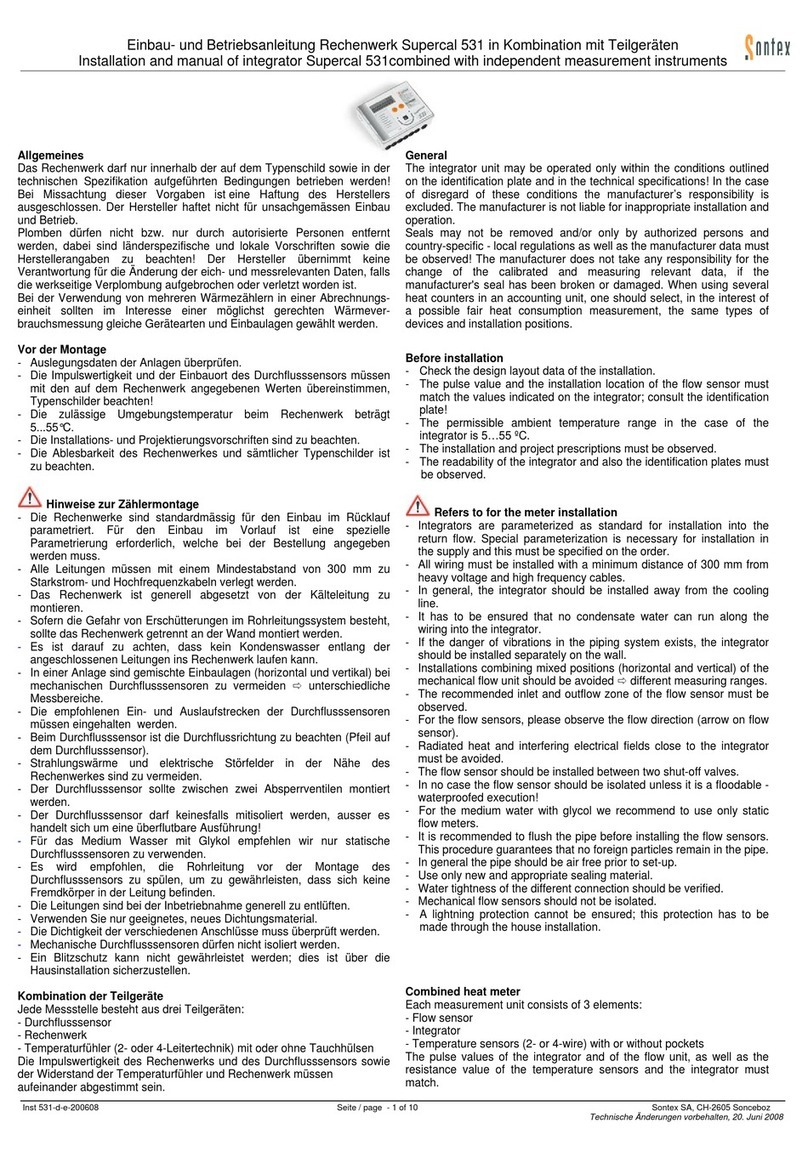
Sontex
Sontex Supercal 531 Installation and manual
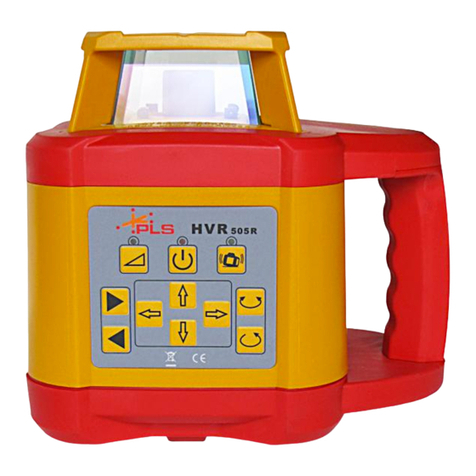
PLS
PLS HVR 505 operating manual

Jinsaixun electronics technology co., ltd
Jinsaixun electronics technology co., ltd SM-2008 Operator's manual
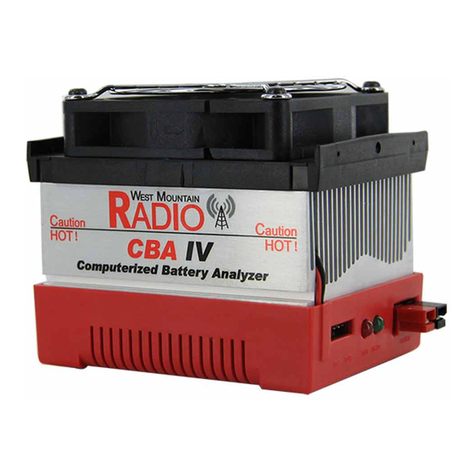
West Mountain Radio
West Mountain Radio CBA IV manual

Kusam-meco
Kusam-meco KM 1120 Operation manual
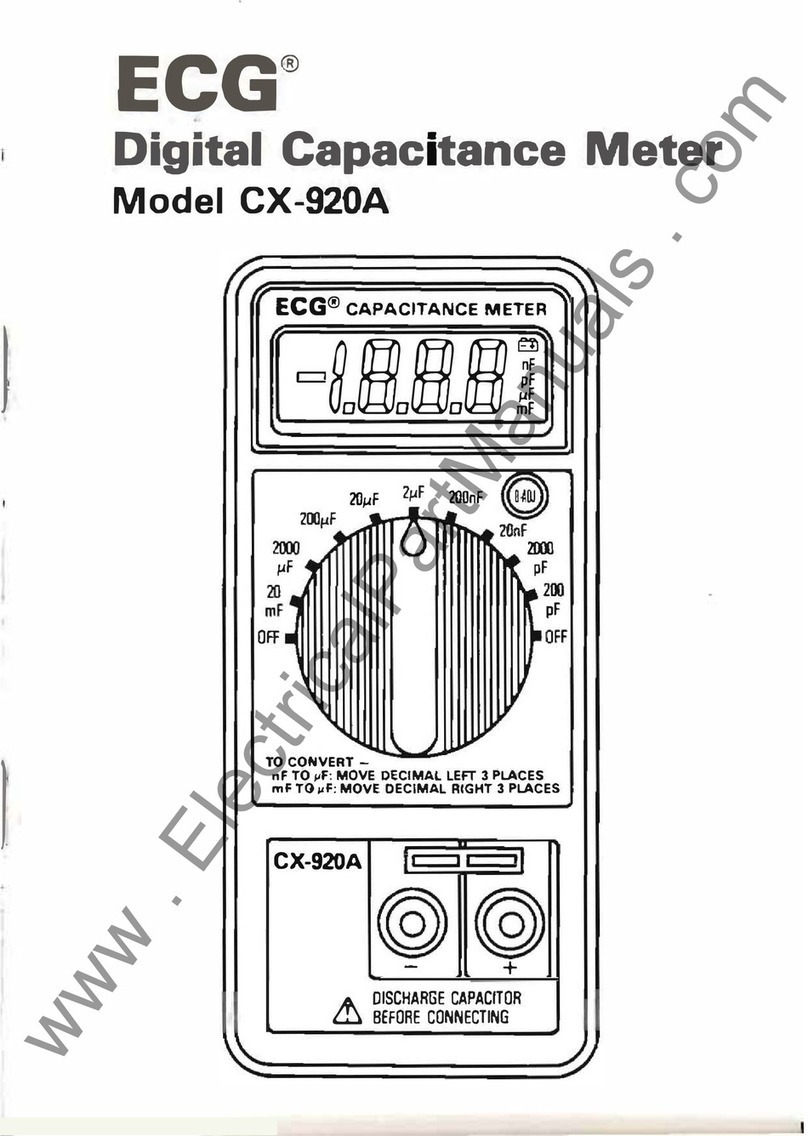
ECG
ECG CX-920A user manual
